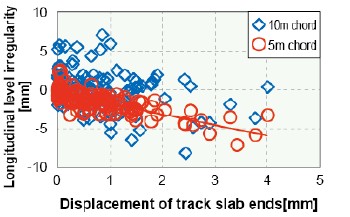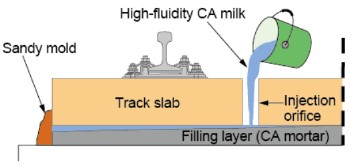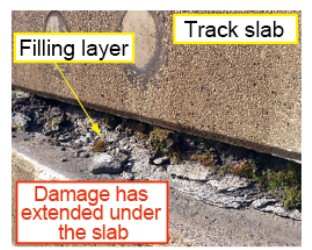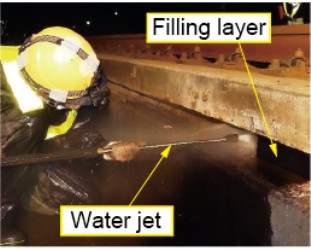16.Method for detecting damage and repairing slab track cement asphalt mortar layers
Slab track can be subject to major damage due to gaps forming underneath it or erosion on its sides up to several dozen centimetres in size, due to frost damage etc. This kind of damage is very cumbersome to repair. The change in support due to deterioration appears on each 5m track slab. Using this characteristic, a more efficient method by 5m-chord longitudinal level irregularity was proposed to detect deteriorated slab track sections from track inspection data (Fig. 1).
Gaps under track slabs can be repaired using resin injections. However, due to cost of materials and workability, this method is seldom employed. As such, a new method for renovating slab track was developed which reduces costs by 40% compared to existing materials. The method uses high-fluidity CA milk (slurry) injected using a sandy mould to fill the gap (Fig. 2).
A new method was then developed to renovate large sectional areas, whereby an inspection rod is used to estimate the extent of the deteriorated area, which is subsequently cleared using a water jet and then injection-filled using frost-damage resistant renovative CA mortar (Figs. 3 and 4). This method reduces the cost of repairing damaged sections by 50% compared to present methods which completely replace the CA mortar layer.
Results from applying the gap repair and large-section renovation work to a commercial line demonstrated that dynamic displacement of the track was reduced, and could be kept below 1/10 (Fig. 5).
Other Contents
- 13.Sheet pile reinforcement work on pile foundations during ground liquefaction
- 14.Countermeasure for fatigue cracks around I-beam bridge supports
- 15.Countermeasure work on ballasted Shinkansen track to prevent ballast migration
- 16.Method for detecting damage and repairing slab track cement asphalt mortar layers
- 17.Decision-making support system for planning replacement of wooden-sleepers with PC sleepers in curved sections
- 18.System for inspecting obstruction warning signals
- 19.Possibility of practical application of a 920MHz bandwidth network
- 13.Sheet pile reinforcement work on pile foundations during ground liquefaction
- 14.Countermeasure for fatigue cracks around I-beam bridge supports
- 15.Countermeasure work on ballasted Shinkansen track to prevent ballast migration
- 16.Method for detecting damage and repairing slab track cement asphalt mortar layers
- 17.Decision-making support system for planning replacement of wooden-sleepers with PC sleepers in curved sections
- 18.System for inspecting obstruction warning signals
- 19.Possibility of practical application of a 920MHz bandwidth network





